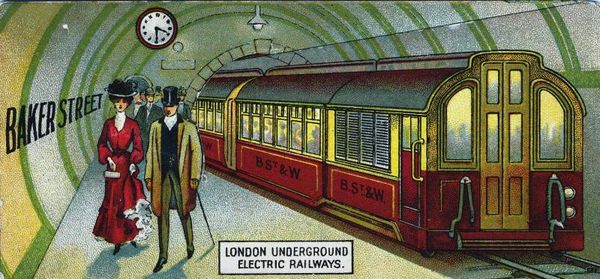
The Bakerloo line
Key facts
Length: 23.2km
Stations: 25
Opened: 1906
Introduction
The Bakerloo opened in 1906 and now runs from the Capital’s north-west suburbs to inner city south-east London, between Harrow & Wealdstone (two adjacent districts) and Elephant & Castle (a historic pub). It has been through more changes than most other Tube lines. At one time it had 45 stations, but now serves only 25. Its history is linked to both the oldest line on the Underground, the Metropolitan, and the youngest, the Jubilee.
Why is it called the Bakerloo line?
A journalist coined the nickname Bakerloo in a newspaper column as a contraction of the Baker Street & Waterloo Railway, shortly after it opened in 1906, and it was quickly adopted by the company. Early maps feature the full name, but by summer 1908 Bakerloo was used.
Did you know?
The Bakerloo has been consistently brown on Underground maps since 1908, but when it opened, its signs were green
History
Starting life as the Baker Street & Waterloo Railway, it was one of the early railway companies set up after the success of the first electric tube, the City & South London Railway (C&SLR) in 1890. As always, raising capital was a struggle, and its original backers went bust midway through tunnelling in 1901.
It was saved by the American financier Charles Tyson Yerkes, who tempted new shareholders with a percentage of profits rather than dividends. It became part of Yerkes’ Underground Electric Railways company of London (UERL) and was the first of his three new railways to open in March 1906.
All three of the ‘Yerkes Tubes’ had the same architect, Leslie Green, and they shared many common and distinctive features – steel-framed buildings with oxblood-tiled exteriors, flat roofs and wide arched windows at first floor level.
Expansion
The line originally opened between Baker Street and Kennington Road (Lambeth North), but soon extended further south to Elephant & Castle. By June 1907 it had reached Edgware Road to the north and had 11 stations.
The next extensions were not built until 1913, when the line opened to Paddington. Other stations followed despite the outbreak of the First World War in August 1914. New tunnels enabled a connection to Willesden in 1915 and over the London & North Western Railway’s lines as far as Watford Junction two years later.
Did you know?
Maida Vale on the Bakerloo was the first station to be staffed entirely by women when it opened in 1915, during the First World War
The formation of London Transport (LT) in 1933 brought more changes. The unification of all of London’s public transport allowed full coordination and control for the first time, including links between the Bakerloo and the previously independent Metropolitan Railway, a reluctant partner in the new authority.
New Bakerloo tunnels were built below the Metropolitan between Baker Street and Finchley Road to relieve overcrowding. Bakerloo trains also started running alongside the Metropolitan to Wembley Park, taking over the recently opened Stanmore branch in 1939. Forty years later this branch transferred to the new Jubilee line.

Plans to extend the Bakerloo south from Elephant & Castle were first proposed in the 1930s and 1940s (to Camberwell), and again in the 2000s (to Lewisham). Nothing came from these earlier plans, but in 2019 Transport for London (TfL) conducted consultations on a proposed future extension to Lewisham via Old Kent Road, to open in around 2030 and potentially link to Hayes and Beckenham.
Did you know?
Culex molestus is a breed of mosquito that inhabits the Bakerloo line and is unique to London Underground tunnels
















